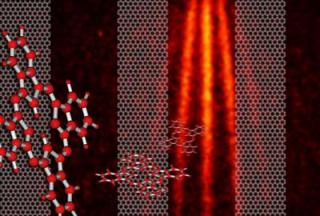Aug 26 2015
The quantum mechanical wave nature of matter is the basis for a number of modern technologies like high resolution electron microscopy, neutron-based studies on solid state materials or highly sensitive inertial sensors working with atoms.
 Modern fabrication methods allow to make atomically thin nanomasks which prove to be sufficiently robust for experiments in molecular quantum optics. Credit: Copyright: Quantennanophysik, Fakultät für Physik, Universität Wien; Bild-Design: Christian Knobloch
Modern fabrication methods allow to make atomically thin nanomasks which prove to be sufficiently robust for experiments in molecular quantum optics. Credit: Copyright: Quantennanophysik, Fakultät für Physik, Universität Wien; Bild-Design: Christian Knobloch
The research in the group around Prof. Markus Arndt at the University of Vienna is focused on how one can extend such technologies to large molecules and cluster.
In order to demonstrate the quantum mechanical nature of a massive object it has to be delocalized first. This is achieved by virtue of Heisenberg's uncertainty relation: If molecules are emitted from a point-like source, they start to 'forget' their position after a while and delocalize. If you place a grating into their way, they cannot know, not even in principle, through which slit they are flying. It is as if they traversed several slits at the same time. This results in a characteristic distribution of particles behind the grating, known as the diffraction or interference pattern. It can only be understood if we take the particles' quantum mechanical wave nature into account.
At the technological limit
In a European collaboration (NANOQUESTFIT) together with partners around Professor Ori Cheshnovsky at Tel Aviv University (where all nanomasks were written), as well as with support by groups in Jena (growth of biphenyl membranes, Prof. Turchanin), and Vienna (High-Resolution Electron Microscopy, Prof. Meyer) they now demonstrated for the first time that such gratings can be fabricated even from the thinnest conceivable membranes. They milled transmission masks into ultra-thin membranes of silicon nitride, biphenyl molecules or carbon with a focussed ion beam and analysed them with ultra-high resolution electron microscopy. The team succeeded in fabricating stable and sufficiently large gratings even in atomically thin single layer graphene.
In previous quantum experiments of the same EU collaboration, the thickness of diffraction masks was already as thin as a hundredth of the diameter of a hair. However, even such structures were still too thick for the diffraction of molecules composed of dozens of atoms. The same force that allows geckos to climb walls restricts the applicability of material gratings in quantum diffraction experiments: Molecules are attracted to the grating bars like the geckos' toes to the wall. However, once they stick to the surface they are lost to the experiment. A grand challenge was to reduce the material thickness and thus the attractive interactions of these masks down to the ultimate limit while retaining a mechanically stable structure.
"These are the thinnest possible diffraction masks for matter wave optics. And they do their job very well", says Christian Brand, the lead author of this publication. "Given the gratings' thickness of a millionth of a millimetre, the interaction time between the mask and the molecule is roughly a trillion times shorter than a second. We see that this is compatible with high contrast quantum interference".
A thought experiment of Bohr and Einstein
The bars of the nanogratings look resemble the strings of a miniature harp. One may therefore wonder whether the molecules induce vibrations in these strings when they are deflected to the left or the right during quantum diffraction. If this were the case the grating bars could reveal the molecular path through the grating and quantum interference should be destroyed. The experiment thus realizes a thought experiment that was discussed by Nils Bohr and Albert Einstein already decades ago: They asked whether it is possible to know the path a quantum takes through a double slit while observing its wave nature. The solution to this riddle is again provided by Heisenberg's uncertainty principle: Although the molecules give the grating a little kick in the diffraction process this recoil remains always smaller than the quantum mechanical momentum uncertainty of the grating itself. It therefore remains undetectable. Here it is shown that this applies even to membranes that are only one atom thick.